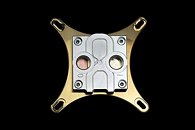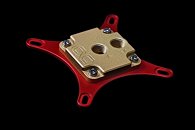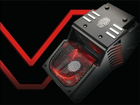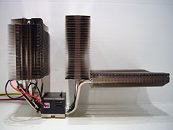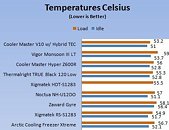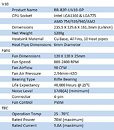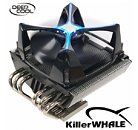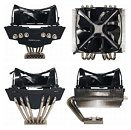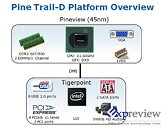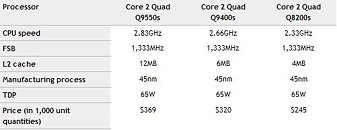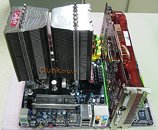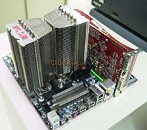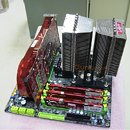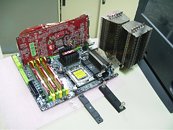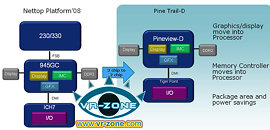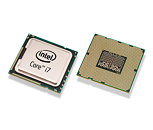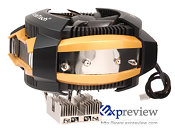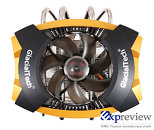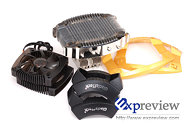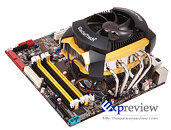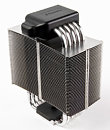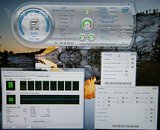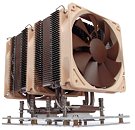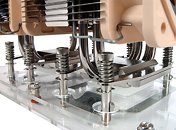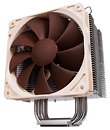
Graphics market seems to be already small enough for NVIDIA, so the green corporation looks further ahead into building a x86 processor in the near future. At the Morgan Stanley Technology Conference in San Francisco yesterday, the company revealed that it had plans to enter the x86 processor market by building a x86 compatible system-on-chip in the next two to three years. Michael Hara, NVIDIA's senior vice president of investor relations and communications, commented:
I think some time down the road it makes sense to take the same level of integration that we've done with Tegra ...... Tegra is by any definition a complete computer on a chip, and the requirements of that market are such that you have to be very low power, very small, but highly efficient. So in that particular state it made a lot of sense to take that approach, and someday it's going to make sense to take the same approach in the x86 market as well.
He also said that NVIDIA's future x86 CPU wouldn't be appropriate for every segment of the market, especially the high-end of the PC market which includes gaming systems, graphics engineering stations and many other. The x86 chip will be mainly targeted at smaller system-on-chip platforms. No other details were unveiled at the time of this publication. It's also very early to talk about something that's still on paper.

Intel's Pentium Dual-Core E5200 processor is getting on course for a specifications update. The chip will feature in a new, improved Wolfdale-2M core, spec'd out as the R0 stepping, from its current M0 stepping. The new stepping is intended to add new instructions, power-management features, and bring about changes in the chip-package. A short list of known changes is as follows:
- CPUID changed from 10677 to 1067A
- Power State Indicator (PSI) support with Intel 4 series chipsets
- New instructions - XSAVE and XRSTOR
- New S-spec and MM numbers
- New halide-free chip package
Due to the changed CPUID, users may require BIOS updates to detect the CPU. According to the company, E5200 R0 should be out by April 13.
German cooling specialist Alphacool released two new CPU water blocks that boast support for all existing and upcoming Intel sockets, the HF 14 series. Its two members are Livingstone and Yellowstone. While both have an identical retention mechanism design, the block design itself is where the differences lie. The Livingstone uses a bilateral-symmetric design, while for the Yellowstone block, the inlet is positioned in the center, to gush right onto the heat-exchange fins.
The company is yet to publish data-sheets for the water blocks, so we could tell you more, though they have been
listed on the company store. The Livingstone block sells for 59.95 €, while the Yellowstone is priced significantly higher at 74.95 €. Both blocks support Intel LGA-775, LGA-1366 and promise support for the upcoming LGA-1160/LGA-1156 socket. Pictured below, in order are Livingstone and Yellowstone (red RM brace).

Cooler Master has gone full cylinders with innovation for the design of the V10 Hybrid TEC, a variant of the V10 cooler that employs a 70W TEC (Thermo-electric couple) element to indirectly cool the processor. The principle on which it works is fairly simple: A set of heatpipes propagate through the CPU contact block. The same heatpipes make contact with the cold-plate of the TEC. The hot-plate of the TEC is cooled by a dedicated aluminum fin array which is subjected to air flow. The heatpipes that cool the CPU propagate into two additional, independent aluminum fin arrays. All this, neatly packed into the shroud. The TEC part of the cooler has its own Molex power input, and is regulated by a temperature control module. The two fans in place to cool the fins use standard 3~4 pin fan connections. TweakTown put this cooler to test against most common high-end air coolers.
In theory, this is a good concept, though the indirect cooling the TEC element provides, isn't going to send temperatures down to sub-zero levels. Instead, the estimates on its spec. sheet shows it to maintain temperatures between 25 and 70 degrees Celsius. The cooler however, is rated for CPUs with TDPs of up to 200W (a figure achieved during overclocking). The findings of the review, however, show the cooler to be not much of an improvement over most high-end air coolers. The review can be read
here.
After introducing some of the most efficient CPU coolers, the Japanese cooling specialist, Scythe, is now planning to launch a new cooler named KillerWhale, designed and manufactured originally by DeepCool, distributed by Scythe. This cooler is specifically designed keeping the Intel LGA-1366 socket in mind, where a slightly bigger, rectangular base serves the application better.
The most characteristic feature of this cooler is its large, rather thick fan and sweep area. Its construction seems fairly simple: six heatpipes arise from a rectangular copper CPU contact block, which convey heat to an aluminum fin array that propagates along the plane of the motherboard. The entire cooler measures 54.5 x 143 x 143.5 mm, and weighs 900g (around 2 lbs). The 120mm fan rotates at speeds between 800 and 1800 rpm to dole out up to 78.32 CFM of air. The KillerWhale supports Intel LGA-1366, LGA-775, AMD AM3, AM2+, AM2, 940 and 939 sockets. It will hit stores soon.

More Details Trickle in on Intel's New Atom Platform, the Pine Trail-D Based Nettop
Following the story which we
covered just a few days ago, Expreview has got more information on the new Intel Atom platform, codenamed Pine Trail-D. From the new information, we see that the CPU, IGP and MCH will in fact all be integrated into one chip, as opposed to just being moved onto the same die. The CPU has also been listed as at least 1.6Ghz, double that of the current entry level Atom processor. Despite the platform having no need for a northbridge, with it all moved into the CPU, Intel have managed to keep the die size at 484 sq. mm. On that note however, it seems that the IGP is still DirectX 9 based, though further details on the graphical capabilities are still not yet known. We also see, that the new Tigerpoint southbridge, will support 8 USB devices, 4 PCI-E x1 lanes, 2 PCI ports, 2 SATA ports and HD audio.

The guys over at Hexus.net, have got hold of information that shows details of three new quad core processors with a thermal design power (TDP) of only 65W. The interesting thing is that it seems Intel have still not yet given up the LGA775 socket despite it being superceded. These are the lowest TDP quad cores from Intel to date, based on a 45nm manufacturing process, and in theory using up to 30W less power than current quad core processors, it shows a step in the right direction. Unfortunately it cannot be all good news, as it seems that the expected prices for these are approximatly $100 more than the similarly clocked 95W counterparts.
Clunk.org.uk have got hold of some photos of what appears to be a DFI LanParty branded CPU Cooler. The design is something new, featuring 6 heatpipes, effectively acting as 12 and with two independant heatsinks. No details such as pricing or availability accompany the images, but it is believed DFI are in collaboration with Thermalright and as such this could be a joint venture between them. The cooler seems to be held on with a prototype bolt on kit, which one would expect to change before the product reaches retail.

According to VRZone, Intel is planning to launch the next generation of Atom CPU's in Q4 2009 with a 45nm single core version, codenamed Pineview, a dual core CPU will shortly follow in Q1 2010. It seems Intel are gearing up to a single chip solution and with this particular generation of Atom, the CPU will be joined by the IGP and memory controller and is based on Lincroft Architecture. There also appears to be a new southbridge in the works to accompany this new chip. No longer do we have ICH-XX variants, but instead this new piece of silicon has been called Tiger Point. Between the two the platform will be known as the Pine Trail-D and will support memory speeds of upto 800Mhz DDR2. Intel claims there will be a 70% reduction in total kit package size and a 50% reduction in total kit TDP.

The the coming months, AMD is planning to launch a series of quad-core and triple-core processors to strengthen the company's hold on the sub-$200, even sub-$150 market segment. Intel is reportedly planning a rival lineup of quad-core processors to counter AMD in the segmet. While the Core 2 Quad Q8000 series from Intel makes for its current low-end quad-core CPU lineup, the new lineup will be categorized under the Q7000 series.
Characteristics of the Q7000 series include a total L2 cache size of 2 MB (1 + 1 MB), which is half of that of the Q8000 and a sixth of that of the Q9000 series. The processors will use a narrower 800 MHz FSB and will be built on the 45nm manufacturing process. They will come with rated TDPs of 65W. The first model in this series will be the Core 2 Quad Q7500, which comes with a clock speed of 2.60 GHz. The chip will be priced under US $150, straying into AMD's budget quad-core chip territory.

Intel Corporation introduced its most advanced desktop processor ever, the Intel Core i7 processor. The Core i7 processor is the first member of a new family of Nehalem processor designs and is the most sophisticated ever built, with new technologies that boost performance on demand and maximize data throughput. The Core i7 processor speeds video editing, immersive games and other popular Internet and computer activities by up to 40 percent without increasing power consumption.
Broadly heralded by the computing industry as a technical marvel, the Intel Core i7 processor holds a new world record of 117 for the SPECint_base_rate2006 benchmark test that measures the performance of a processor. This is the first time ever for any single processor to exceed a score of 100 points.

Believe it or not, although the Core i7 processors have just became available, Intel won't be giving up on its LGA 775 product line-up. According to the trustworthy reporters at DailyTech, on January 18, Intel will launch three new Core 2 Quad processors with a TDP of just 65W. These will be the Intel Core 2 Quad Q8200s (2.33GHz, 4MB L2 cache, FSB 1333MHz), Q9400s (2.66GHz, 6MB L2 cache, FSB 1333MHz), and Q9550s (2.83GHz, 12MB L2 cache, FSB 1333MHz) models, priced at $245, $320 and $369 respectively. All three models differ from their brothers from the s-letter in their nomenclature. Intel will also launch a new 2.6GHz Pentium Dual Core E5300 processor in November of this year and one more, the 2.7GHz Pentium Dual Core E5400 on January 18th next year. The second CPU will be priced at $84 when available. Lastly, Intel's power efficient 35W processor lineup will also see some changes at the end of the year. The new T9800 (2.70GHz, 6MB L2 cache, FSB 1066MHz, $530), Q9000 (2.00GHz, 6MB L2 cache, FSB 1066MHz, $348), P9600 (2.66GHz, 6MB L2 cache, FSB 1066MHz, $348), T9550 (2.66GHz, 6MB L2 cache, 1066MHz, $316), and P9600 (2.53GHz, 3MB L2 cache, FSB 1066MHz, $241) will be released then.
Glacialtech, one of Intel's stock-cooler suppliers, has taken a step into the branded high-end cooling segment with its UFO CPU cooler. Expreview took a few snaps of the cooler, which shows a large fin array suspended on four heatpipes, on which two 38 CFM, 92 mm fans blow air downward. The two fans sandwich the aluminum fins, and are covered by sporty black and yellow shrouds. The combined noise of the fans is rated at 28 dBA (at max. speed of 2000 rpm). The cooler supports all current CPU sockets, and is expected to release soon.
Whichever way the global economy is headed, 3Q, 2008 hasn't been a bad period for computer hardware industry. The GPU market saw its bumper sale in six years, with both NVIDIA and AMD reaping inflows. Similar trends were also reported with other sections of the industry. The CPU for one, is commodity closely linked to the growth of the industry. 3Q 2008 saw record earnings for Intel as well, as the silicon giant continued its market-share gains into rival AMD, as recorded by market observer iSuppli.
According to iSuppli figures held by Information Week, Intel now holds a massive 80.4% of the CPU market share, which is up 1.7% from Q3 2007. AMD's share on the other hand fell 1.8 percentage points to 12.1% from 13.9% a year ago. Compared to Q2 2008, AMD's market share grew by 0.1%, and Intel's grew by 0.3%. There is a clear influence of smaller CPU vendors that has affected AMD's share. These smaller vendors are finding it increasingly difficult to compete on a global scale amidst the economic crisis.
Denmark's Danamics LM10 CPU cooler, the world's first commercially available liquid metal-based processor cooler, was reported today to have received a release date. The LM10 will land in Europe as of November 17th, but it will come in limited quantities. Outside of Europe, Danamics is still awaiting approval of its liquid metal-based technology, and after one is obtained the company can start selling.
Recently, Danamics engineers claimed to have developed a CPU cooler that will put to shame every air cooling solution available and most of the current water cooling kits. The LM10 has no moving parts and an unlimited mean time between failures. Inside is a yet-to-be-named liquid metal that's said to provide superior thermo physical properties and is circulated without moving parts thanks to a built-in electromagnetic pump. Expect more information next week.

During IDF Taipei earlier last week Intel demonstrated its DCC (Desktop Control Center) overclock software for the forthcoming Intel Core i7 processors. The DCC is a easy to work with software that will allow overclocking in Windows environment and help novice overclockers and experts. The Desktop Control Center can adjust CPU multiplier, voltage, memory timings and clock speed as well as various system voltage options such as the QPI voltage. The DCC also gives you the option to switch on and off Turbo Boost in Windows, and monitor system temperature readings.

Today, AMD is announcing two new processors to its products line - AMD Phenom X3 8850 Black Edition and AMD Athlon X2 5050e. The Socket AM2+ triple core X3 8850 (TRAY OPN# HD8850WCJ3BGH) works at 2.5GHz, has a TDP of 95W and 2MB of L3 cache. The Phenom X3 8850 is the first triple-core Phenom processor to be part of the company's Black Edition series and as such it has unlocked multiplier for overclocking. The AMD Athlon X2 5050e (TRAY OPN# ADH5050IAA5DO) is a dual-core 45W processor that operates at 2600MHz.
Sooner or later AMD is also expected to commence shipments of two low-power chips - the single-core 1.6GHz Athlon 2650 (TDP 15W), and the dual-core Athlon X2 3250e, running at 1.5GHz and requiring up to 22W. November will also see AMD's "Ultra-Value Client (UVC) Solutions", the chips that will possibly compete with Intel Atom CPUs for netbooks. These are only for the OEM customers, though.

Intel Clarksfield, the company's Nehalem based mobile platform, was reported on Monday to begin production in the second half of 2009. Although mass production of the first Core i7 processors is scheduled for next month, on the mobile front Intel users will have to wait until late next year. Clarksfield will be produced using the same 45-nanometer production process that's used to make Intel's current chip lineup. The upcoming chip will be the heart of a new Intel Centrino platform, codenamed Calpella. As its desktop variant, Clarksfield CPUs will have all the enhancements Nehalem offers, as well as the brand new integrated memory controller all in one package. Clarksfield is also expected to include more advanced power-management features than Intel's current mobile chips.

Noctua today released four new CPU coolers for Intel Xeon and AMD Opteron processors. Optimized for use in dual socket systems, the new DX (Dual Xeon) and DO (Dual Opteron) versions of Noctua's highly successful NH-U12 and NH-U9 series introduce the premium quality quiet cooling performance that has become synonymous with Noctua to the world of professional workstations and servers. "Maximum cooling performance at minimum noise levels and excellent reliability can be particularly important when it comes to high-end workstations and special server applications", explains Mag. Roland Mossig, Noctua CEO. "Due to the ever-growing demand for our Xeon and Socket F mounting kits, we decided to design new, customized versions of our coolers that are completely tailor-made for use on Intel Xeon and AMD Opteron systems, especially dual socket configurations. Enter the DX/DO series!"

Intel has updated its plans with the desktop CPU lineup across segments with some of the current products getting discontinued from manufacturing. The company will send product discontinuance notices (PDNs), documents sent to relevant firms in the industry, notifying them of a time-frame in which the company plans to stop production of a product. Some products are also slated to reach end of life (EOL). Along with this, there are also plans to bring in new products based on the current architecture.
Sources at motherboard vendors tell that by Q1 2009, the Core 2 Extreme QX9770 and QX9650 discontinue, with PDNs being issued. They will be totally phased-out by Q2. The company will also send out PDNs for four quad-core CPUs including the Core 2 Quad Q9450, ten dual-core CPUs including the Core 2 Duo E8300, three Pentium CPUs including the Pentium E2220 and the Celeron E1200 starting in November, and all products will phase out between the first and second quarters next year. Other highlights include:

DigiTimes made today the early announcement of two low-power AMD desktop processors that are to appear sometime in November. The Athlon 2650E and Athlon X2 3250E will both be part of the company's UVC (Ultra-Value Client) product line targeting OEMs. The single core 2650E CPU will have a core frequency of 1.6GHz and TDP of 15W, while the dual-core Athlon X2 3250e will have a core frequency of 1.5GHz and TDP of 22W. The two CPUs will be fabbed on a 65nm process and will initially be provided to OEM customers only. Manufacturers like ASUSTeK Computer, Acer and Shuttle, are expected to show up machines powered by the two processors in December. In additional news, AMD is also planning to launch a triple-core Phenom X3 8850 CPU using a 65nm process in early October. The CPU will feature a core frequency of 2.5GHz and a maximum TDP of 95W. The company will also launch a new Black Edition CPU in December.
Chinese researchers unveiled details of a general-purpose microprocessor with which they hope to give computing to the most ordinary people in China. The chip, code-named "Godson-3", was developed with government funding by more than 200 researchers at the Chinese Academy of Sciences' Institute of Computing Technology (ICT). Analysts suggest this takes China one step closer technological independence.
These chips are being manufactured by ST Microelectronics and branded as "Loongson" meaning Dragon Chip. Predecessors of this chip have been manufactured since 2001 and with its advancement marks rapid propagation of the Linux platform and other open-source software. These PCs would make it to as many workplaces and schools as the Chinese government can take them to. It is noted that the Godson-3 that has four processing cores releases in 2009 with a design that is scalable. In fact an 8-core version is planned as well. These chips use the 65nm fabrication process, with the 4-core version rated to consume as low as 10W. An interesting bit on the machine architecture is that these chips aren't x86 per say, but the designers have added instruction sets to simulate an x86-like environment. With it they hope to run a broader range of software, Microsoft Windows included. Since its a simulated x86 environment, a license from Intel isn't required. Erik Metzger, a patent attorney at Intel, says that the chip will only perform at about 80% of the speed of an actual x86 chip.

Without doubt, AMD needs something revolutionary to pull it out of the mess it set itself in. AMD's first reaction to the Conroe onslaught was to lower prices and build up a "Smarter Choice" repute, though with successive price cuts from Intel and down-scale products based on the Core architecture coming out by the fortnight, and the transit to 45nm fab process, there's been an increasing need for AMD to get back to the drawing boards with their CPU division.
From what looks like an excerpt from an AMD company slide, can be seen AMD's CPU plans for 2009. The chart broadly shows that K10 architecture is here to stay. Throughout the year, desktop CPUs based on the K10 architecture feature in the roadmap, with no signs of their "truly next-gen" architecture. AMD completes its transit to the 45nm silicon fabrication process and will finally embrace DDR3 system memory standards. To begin with, the fact that the Deneb core's entry slightly steps into the 2008 column shows that the Deneb core-based desktop CPU could release sometime towards the very end of this year. Sources note that two models based on the Deneb core could be out by the end of this year. It supports both DDR2 and DDR3 memory standards and socket compatible with current AM2+ and future AM3. From what's known so far, AM3 is the same 940 pin design that adds pins for the DDR3 memory interconnect between the CPU and the memory.

After Intel slashed the prices of several dual and quad core processors in the beginning of the week, today AMD informed it is tweaking the prices of three Phenom CPUs, too. First to receive price reduction is the 2.1GHz clocked triple core Phenom X3 8450, going down from $125 to $104. Second one is the 2.2GHz Phenom X4 9550 lowering down from $175 to $154. Third and final is the 2.6GHz X4 9850 Black Edition down from $205 to $194. All prices are for 1000-unit tray quantities.

Intel will release four mid-thru-high range desktop processors tomorrow. These CPUs will be based on the 45nm Yorkfield and Wolfdale cores. Two new Core 2 Quad models, the performance segment Q9650 and the mainstream segment Q9400 are dressed up. The Q9650 has identical parameters to the Core 2 Extreme QX9650 barring the locked FSB multiplier of 9x. The Q9400 is an improvement over the current Q9300. It has a 2.66 GHz core clock speed with a total of 6 MB L2 cache and an FSB multiplier of 8x.
With the Core 2 Duo, there is a top of the line dual core chip, the E8600 which comes with 3.33 GHz core speed, 6 MB of L2 cache and an FSB multiplier of 10x. There's also a mid-range offering, the E7300 that comes with 2.66 GHz core speed, 1066 MHz FSB and an FSB multiplier of 10x. It has 3 MB of L2 cache.



